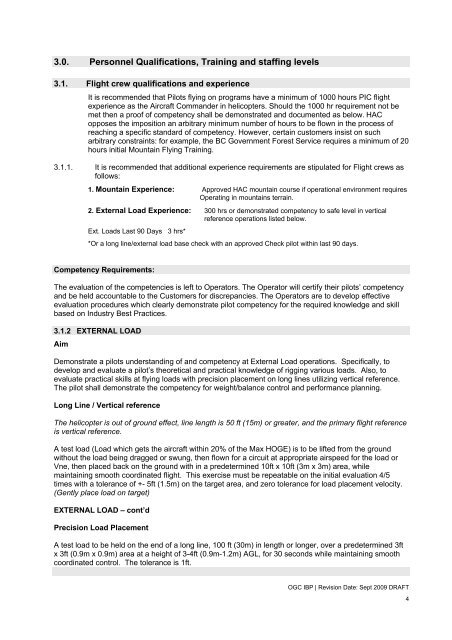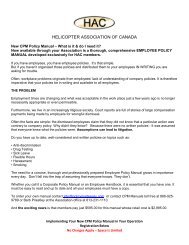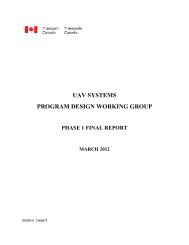HAC Oil & Gas IBP - Helicopter Association of Canada
HAC Oil & Gas IBP - Helicopter Association of Canada
HAC Oil & Gas IBP - Helicopter Association of Canada
Create successful ePaper yourself
Turn your PDF publications into a flip-book with our unique Google optimized e-Paper software.
3.0. Personnel Qualifications, Training and staffing levels3.1. Flight crew qualifications and experienceIt is recommended that Pilots flying on programs have a minimum <strong>of</strong> 1000 hours PIC flightexperience as the Aircraft Commander in helicopters. Should the 1000 hr requirement not bemet then a pro<strong>of</strong> <strong>of</strong> competency shall be demonstrated and documented as below. <strong>HAC</strong>opposes the imposition an arbitrary minimum number <strong>of</strong> hours to be flown in the process <strong>of</strong>reaching a specific standard <strong>of</strong> competency. However, certain customers insist on sucharbitrary constraints: for example, the BC Government Forest Service requires a minimum <strong>of</strong> 20hours initial Mountain Flying Training.3.1.1. It is recommended that additional experience requirements are stipulated for Flight crews asfollows:1. Mountain Experience: Approved <strong>HAC</strong> mountain course if operational environment requiresOperating in mountains terrain.2. External Load Experience: 300 hrs or demonstrated competency to safe level in verticalreference operations listed below.Ext. Loads Last 90 Days 3 hrs**Or a long line/external load base check with an approved Check pilot within last 90 days.Competency Requirements:The evaluation <strong>of</strong> the competencies is left to Operators. The Operator will certify their pilots’ competencyand be held accountable to the Customers for discrepancies. The Operators are to develop effectiveevaluation procedures which clearly demonstrate pilot competency for the required knowledge and skillbased on Industry Best Practices.3.1.2 EXTERNAL LOADAimDemonstrate a pilots understanding <strong>of</strong> and competency at External Load operations. Specifically, todevelop and evaluate a pilot’s theoretical and practical knowledge <strong>of</strong> rigging various loads. Also, toevaluate practical skills at flying loads with precision placement on long lines utilizing vertical reference.The pilot shall demonstrate the competency for weight/balance control and performance planning.Long Line / Vertical referenceThe helicopter is out <strong>of</strong> ground effect, line length is 50 ft (15m) or greater, and the primary flight referenceis vertical reference.A test load (Load which gets the aircraft within 20% <strong>of</strong> the Max HOGE) is to be lifted from the groundwithout the load being dragged or swung, then flown for a circuit at appropriate airspeed for the load orVne, then placed back on the ground with in a predetermined 10ft x 10ft (3m x 3m) area, whilemaintaining smooth coordinated flight. This exercise must be repeatable on the initial evaluation 4/5times with a tolerance <strong>of</strong> +- 5ft (1.5m) on the target area, and zero tolerance for load placement velocity.(Gently place load on target)EXTERNAL LOAD – cont’dPrecision Load PlacementA test load to be held on the end <strong>of</strong> a long line, 100 ft (30m) in length or longer, over a predetermined 3ftx 3ft (0.9m x 0.9m) area at a height <strong>of</strong> 3-4ft (0.9m-1.2m) AGL, for 30 seconds while maintaining smoothcoordinated control. The tolerance is 1ft.OGC <strong>IBP</strong> | Revision Date: Sept 2009 DRAFT4









